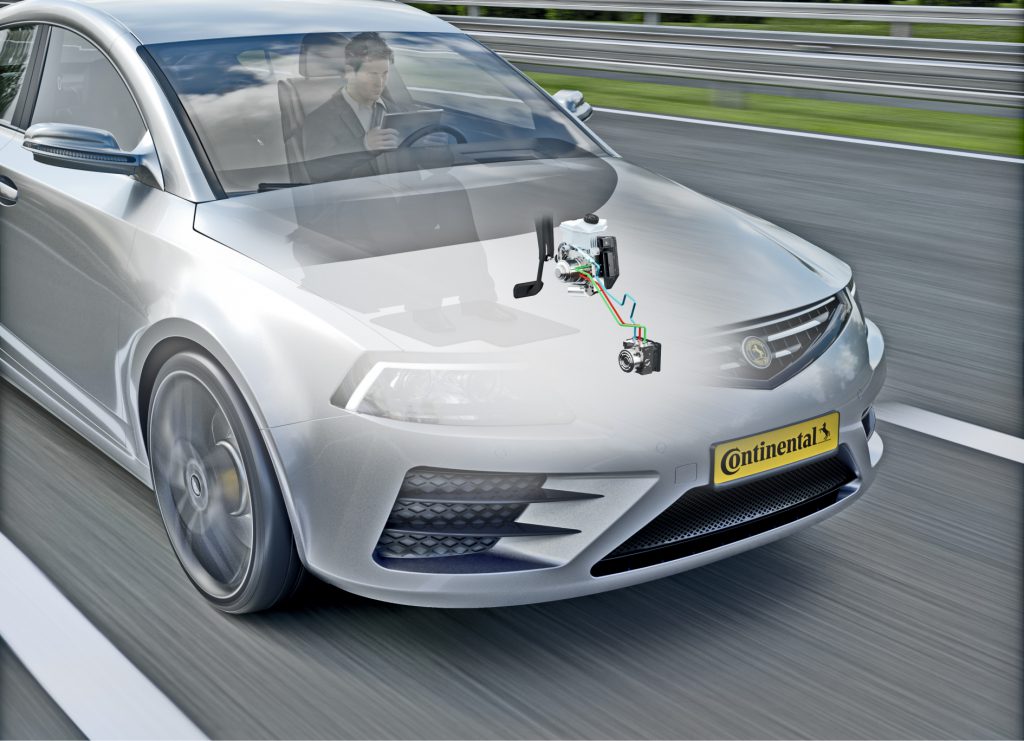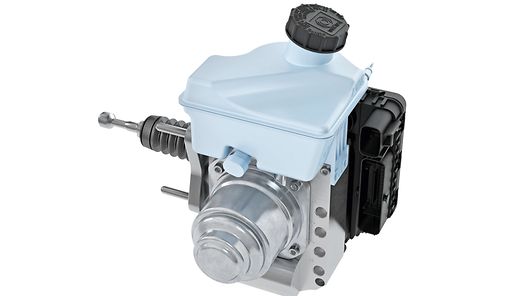This post is also available in: German
- The MK C1 for highly automated driving (HAD) has now a redundant fall-back level.
- The MK C1 HAD system architecture with two networked braking system units offers a stepped degradation concept to ensure the required deceleration level at all times without driver interaction.
- By combining the MK C1 with a MK 100 based Hydraulic Brake Extension (HBE), redundant braking systems for highly automated driving can be installed with minimum effort.
Frankfurt am Main, Germany, August 1, 2017. While automated driving is a big step into the future of safe and comfortable individual mobility, one thing will not change: In conjunction with the steering, the brakes will remain the most important element of active safety. Once the driver hands over the full driving responsibility to the vehicle, the electronic brake system (EBS) must be capable to perform the braking function, even in a rare case of a possible failure of the primary electronic brake system. That is why the technology company Continental has developed its electronic brake solution MK C1 further, targeted to the additional requirements of highly automated driving.
Fall-back option for the brake system is a must have when it comes to HAD
„Highly automated driving poses tough requirements to the braking system“, said Felix Bietenbeck, Head of the Vehicle Dynamics business unit at the Continental Chassis & Safety Division. „We have used our broad braking technology expertise to design an enabling solution for the next practical step towards automated driving for several of our customers. The MK C1 for highly automated driving makes cutting-edge brake technology available to a new application with new challenges.”

As the MK C1 is a by-wire system, which offers a particularly fast, precise and autonomous pressure build-up, it is ideally suited for automated driving. To achieve the requirements of braking redundancy, Continental has combined the MK C1 with a derivative of the MK 100 ESC. In normal operation mode, the MK C1 unit provides all braking, stability and comfort functions. The hydraulic pressure simply passes through the MK 100 Hydraulic Brake Extension (HBE). In order to ensure 100 percent availability at all time the MK 100 HBE performs frequent self-tests.
Cooperative mode maximizes the availability of braking functions
Should the primary EBS fail in a very unlikely rare case, the secondary EBS will step in and provide the required braking function. Depending on the type of potential failure in the primary EBS, two things can happen: Should the primary EBS fail completely – a highly unlikely scenario – the MK 100 HBE unit will brake the vehicle with the front wheels and provide an ABS function.
However, the MK C1 has another benefit to offer. Currently, Continental develops a cooperative brake mode. This will apply if the electromechanical actuation and pumping function of the primary braking systems should fail without affecting the unit’s control valves. In this case the MK 100 HBE unit will go into the cooperative brake mode. A part of its hydraulic pressure will be fed to the still functional MK C1 valves to activate the rear brakes as well. This innovative flexible split of functions ensures a full autopilot braking function with slip controlled deceleration on both axles even in a situation of partial-failure in one system. “The principle of networking two EBS units is a complex and challenging task. It requires an outstanding system know-how, which Continental has”, Bietenbeck concluded.

The MK C1 is Continental’s latest innovative brake system and has been in production since 2016. It makes a major contribution to safe and dynamic driving, as well as energy efficiency. It enables 100 percent recuperation of braking energy, thanks to the “brake-by-wire” design. Further benefits include an approximate 30 percent weight reduction of the system and efficient braking dynamics in a compact unit. The innovative electronic brake system integrates the tandem master cylinder (TMC), brake booster and control systems (ABS and ESC) into a compact, weight-saving one box design module. Continental’s MK C1 can build up braking pressure in 150 ms (time-to-lock), which is twice as fast as conventional systems today.
Continental will also show the MK C1 for highly-automated driving during the International Motor Show, IAA in Frankfurt/Main (Hall 5.1. Booth A07 / A08).
Press contact
Soeren Pinkow
External Communications
Continental
Division Chassis & Safety
Guerickestr. 7
60488 Frankfurt am Main, Germany
Phone: +49 69 7603-8492
E-mail: soeren.pinkow@continental-corporation.com
Miriam Baum
External Communications
Continental
Chassis & Safety Division
Guerickestr. 7
60488 Frankfurt am Main, Germany
Phone: +49 69 7603-9510
E-Mail: miriam.baum@continental-corporation.com



